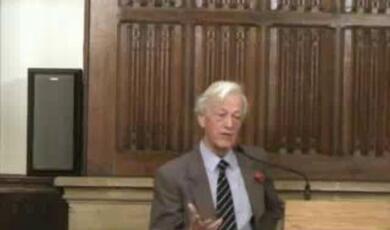How far down the road to recovery is the UK and how much more austerity is needed?
Share
- Details
- Text
- Audio
- Downloads
- Extra Reading
Charles Davis, Director of Cebr, offers an analysis of the UK Budget, which was announced by the Chancellor on the morning of the lecture.
The subjects covered by this lecture includes:an update on the global economic outlook an assessment of the UK forecast a review the Chancellor’s 2014 budget an analysis of the outlook for public finances over the coming years a forecast of the implications for policy over the coming five years
Download Text
How far down the road to recovery is the UK and how much more austerity is needed?
Charles Davis
I did not quite expect to be here, so I cannot profess to have immensely well-prepared lines, but hopefully it will all flow. We have been working on our Budget response today. I lead up the Macroeconomics Team in CEBR, so have been working on the macroeconomic side for the last six or seven years, and so we always prepare a fairly intense afternoon of listening to the radio with Mr Osborne, or previously Mr Darling, and Mr Brown, and noting down what they have said and trying to put it actually in context and work out which bits are important and which bits are not. We have been working on that today, so I am going to give you a few fruits of that labour, and then my aim is to give a bit of an update on where the UK economy is, review some of the aspects of Osborne’s budget, and then try and think, as was just implied, what that means for public finances and how much more we might have to go to fix the public finances over the next five, six years, and just try and critically assess some of the things that Mr Osborne’s said and offered us today, and perhaps also think a little bit, which I think is really where Professor McWilliams’ research, has been heading, is looking at what is the sustainable level of Government spending and how does the UK fit into the international context, should we be trying to compare ourselves with other advanced economies, or should we be comparing ourselves with emerging markets and such like.
The global backdrop, I think, to put it simply, is increasingly benign for the UK. While global trade is growing still beneath its long-run trend, actually it has recovered a bit from where it has been in the funk of 2011 and 2012, and we are getting back towards that long-run trend. But it is still a bit weaker than certainly the period before the financial crisis, so there is still not a totally healthy global recovery, but as far as the UK is concerned, I think that it is a more encouraging story because the growth is being led by the advanced economies, and as much as the UK is focused on trying to re-balance towards the emerging markets, and that of course has been a dominant theme of Professor McWilliams’ lecture series, looking at the rise of the emerging markets, particular China, and their profound impact on the advanced economies are still hugely significant to UK exporters, so to have the advanced economies recovering and helping to see growth pick up towards 3%, as we think it will be in 2014, up from the low two percents last year, that is an encouraging sign for the UK economy and I think places us in a more benign environment than we have seen in recent years.
Indeed, one of our key export markets, the Eurozone, is finally going to grow this year, so we are looking at growth around 1% to real GDP terms, up from a small decline last year and a slightly larger decline the previous year. So, finally we have growth in one of the UK’s most significant markets, and I think there are signs that we will start to get back to a bit more health in the medium-term and a slightly strongly growth rate.
However, the OBR’s forecast, released today, that is the slightly darker line in the graph that you can see before you, they are probably a bit more optimistic about the medium-term for the Eurozone, and we would probably take a slightly more cautious view. So that will be a bit of a constraint on the UK’s ability to export to the single currency area. I think the Eurozone still remains a significant concern, and a significant risk I think to the UK recovery, given there are lingering problems in places like Greece, Italy, but also in places like France, where Government debt continues to climb, and the deficits are persistently large, and growth has not been well-established and sure-footed in recent years.
Then just looking specifically at the UK’s export markets and putting that story of an increasingly benign environment in which Chancellor Osborne can get up and talk to us about the outlook for the UK economy, when you look at this graph, we have just got oil prices in the black line on the left hand side, and on the green line, we have got the forecast growth from the OBR in the UK’s export markets, so it is weighted for the share of exports that the UK has. You can see that, after a really tough period for our export markets in 2012, even in 2013, when things started to turn around, actually, in 2014 and beyond, we are looking at a much more robust trend growth rate for our export markets.
So, it is an increasingly positive environment in which to be looking for more of an export-led recovery, and in addition, we were buffeted through the last six years, by very high oil and commodity prices, and again, that has been a dominant theme of what Professor McWilliams has been talking about, with the rise of the emerging markets, their resource-intensive demand, and the effect that that has had on global commodity prices. But we are actually, in recent years, with emerging markets slowing a bit, obviously affected partly by the slowdown in the pace at which the Federal Reserve is easing monetary policy by buying government bonds, and a general tendency towards slightly tighter monetary policy, that has certainly hit the emerging markets, and we are seeing slower growth there.
Actually, for the UK, whilst we are looking to tie in to those emerging markets, they are still growing at a pretty solid pace, so there is still plenty of scope to export to them, but with them growing slightly slower, that of course means inflationary pressures across the globe have eased, and so hence we have the central forecast for oil prices to fall back, and that eases the inflationary pressures within which the UK is operating. So I would say it is the most benign environment that we have probably seen in the whole time that Chancellor Osborne has been in post, and probably even since going back to around the time that Chancellor Darling came in, in 2007. You are looking at a much easier climate in which to be operating, with a healthier backdrop.
But what is the outlook for the UK economy and what are the risks? Well, we have had increasingly buoyant indicators on the health of the business and also consumers, so we have seen two indicators that CEBR analysed, the YouGov/CEBR Consumer Confidence Index, and the ICAEW/ Grant Thornton Business Confidence Monitor, alongside also the FSB Small Business Index. All of these indicators have been showing sustained pick-ups. I have just pulled out the ICAEW/Grant Thornton Business Confidence Monitor here, which has just recently passed its 10th anniversary, and you can see that business confidence has gone up to a record level – that is the green line, and actually, although it is only very faint unfortunately on this graph, it tends to lead the overall growth in turnover and in the wider economy. So, it is a very good leading indicator, and it is telling us the economy is accelerating, the economy is sustaining itself, and we are looking at a faster pace of growth in 2014.
Indeed, businesses have been surprised, in a positive fashion rather than a deeply negative sense that we saw in 2008/9, by the pace of growth. So, this graph just shows the differences between the growth rate achieved and what was expected a year ago, and it is standardised to make it comparable with indicators of turnover and profit there, and you can see that, from a period in which there tended to be positive surprises, before the financial crisis, we moved to deeply negative surprises through 2009, but now we are back into a more encouraging picture, where businesses have been surprised by just how good the outturns have been, and that is a more positive environment for the private sector to deliver stronger growth which can help support the public finances in the medium-term.
So, looking at what the big picture outlook for the UK economy is, of course Chancellor Osborne was very pleased to be able to announce it. I think it was the largest upgrade in economic growth for 30 years, between one Budget and the next, going back to the Budget in 2013. I think the forecast back then was only 1.8%, but we are now looking at a 2.7% forecast from the Office of Budget Responsibility. Our view is that it could even be stronger than that, when you look at things like business investment have started to pick up on the back of the confidence that I am talking about, and also the fact that residential investment is continuing at quite a pace. I mean, you simply wander around London and you see the number of cranes in the sky and you see the pace at which residential investment is picking up on the back of the resurgent housing market, and you can see that story right before you. In addition, consumers have been newly confident and have been spending at a reasonable pace, certainly, not at the pace we saw pre-crisis, but there are more and more encouraging signs across the economy.
However, we do think there will be a downturn next year. We think the pace of growth cannot be sustained at the current rate, and we think that consumers are probably going to have to cut back slightly. There are more effects down the line that are going to come in and pose a challenge to consumers in the next few years, notably the potential further tightening of fiscal policy to try and deal with the deficit, which I will come onto in a bit more detail later on, but also the need to tighten monetary policy from the current exceptionally loose levels.
So, I think we expect growth to be constrained in the medium-term, and we do not see quite as optimistic a picture as the OBR, although I have to say they are certainly far more realistic than any forecast we would have seen in the run-up to the previous Election, in 2010. I still find it remarkable that, before the 2010 Election, the Chancellor at the time was effectively allowed to choose the economic forecast which suited him best, so we had the situation in which Chancellor Darling was saying that the economy would grow by over 3% after the previous Election, and of course, none of us economists thought that was at all reasonable a guess, and that then shaped the entire fiscal outlook in terms of driving tax revenues and driving the effect on public borrowing. So, at least this time the political parties of either side will be presumably operating on the same basis, that is, what the OBR thinks will happen to the economy. But, certainly, it is a more positive outlook than we have seen at any point over the last probably six or so years.
However, there are a few nagging concerns, and I just wanted to highlight a few of those, and then move back to thinking about what Chancellor Osborne has come out with today. One of those is export growth. While I have talked about the more benign, the more encouraging backdrop for the UK economy to be operating it, especially as it pertains to the ability to go out and export to the rest of the world, to try and achieve this one trillion exports target by 2020, well actually, we are still struggling quite a bit when you look at the numbers.
So, this graph just shows, from the ICAEW/Grant Thornton data again, the pace of growth in turnover versus exports reported by businesses, a thousand accountants working in UK businesses, every quarter, and you can see that export growth is still lagging behind the up-tick that we have seen in business growth over the last year or so. So, there is still a concern that exports are not picking up and the economy’s not re-balancing towards a more export-led, more sustainable basis.
Again, when you look at the OBR forecast, they do not actually expect net trade, so that is the effect of exports less imports, to contribute to growth at any point over the next five years in their forecasts, not a notable contribution anyway, which is, it goes against the whole narrative of re-balancing the economy and moving towards being more export-competitive and exports playing a bigger role in UK growth. When you look at their forecasts for UK’s export share of global markets, you can see that it is a pretty bleak outlook still. After the trend sector decline in UK’s global export share, you are looking at that continuing, albeit at a slower pace, over the next five or six years.
So, what can be done to try and boost this export performance? Well, I think you see Osborne throwing more resources at UKTI and potentially promising more in terms of export finance, but really it has to come from innovative, productive UK private sector businesses going out and doing their best to compete in global markets, so I guess there is a limit to which Osborne can really pull the levers there and make anything happen. It really has to be a private sector led thing. But I think that, to me still remains a concern, and one of the reasons why we are probably slightly less optimistic than the OBR in the medium-term on our growth outlook.
Then, just looking at what is happening to investment. We have seen a big pick-up in business investment in the last few months, the last few quarters, going along with this buoyant business sentiment that we have seen, as I talked about earlier, but actually coming on the back of years of weak capital investment growth. So, this graph just looks at reported business investment from the ICAEW survey before the crisis, during the last ten years, in the middle bars, and then looking at the post-crisis performance on the far right as you look at it. You can see that, post-crisis, the performance has been markedly weaker than before the crisis. Moreover, the trend has been brought down over the last ten years by the sustained slow pace at which capital investment has been expanding.
So, what can the Government do to try and encourage business investment, and is the business investment story strong enough to really sustain this recovery? Well, the OBR thinks there is going to be quite an increase in business investment. You can see from this graph, which is business investment as a share of GDP, the OBR is expecting business investment to get back up towards 11% of GDP, which was the level we last saw in about 2002, but actually, there had been a sustained decline, not just through the financial crisis, but even before the financial crisis, there tended to be a weakness in business investment in the UK. I do not think we quite believe that it will be quite as blue-sky as that in the next five years or so. There is probably going to be a bit of a weaker trend, but, I mean, one would assume, with a stronger outlook and with perhaps a little bit less uncertainty about stronger sentiment amongst businesses, that we can see a sustained business investment recovery, but I do not quite know if we can match up with 8% annualised growth between 2015 and 2018, which I think is what the OBR have projected. So, that, to me, still remains a concern.
On that, sure enough, Chancellor Osborne has moved and announced, on the face of it, what looks like quite an encouraging policy move, so he has increased the annual investment allowance for businesses, from £250,000 all the way up to half a million, but that comes on the back of having fiddled about with it back in 2011 and actually reduced the annual investment allowance, which went against what Chancellor Darling had penned in before that. So, it is something of a bizarre tinkering around, going down, then going back up, and then increasing again quite substantially. Surely, if you are trying to encourage business investment, the thing they would benefit from most is certainty about the future environment, certainty about the environment in which they are operating, and so it would help to actually have a sustained commitment to this sort of policy rather than jumping it around, but certainly it is a step in the right direction and I daresay might go towards solving this sustained weakness in business investment that we have seen.
I guess, on the more encouraging side, and again, something that Osborne has looked to move on, and not without controversy, and that is the Help to Buy Scheme. It has been extended further and that should help the housing market to continue its recovery, but of course that means different things to different people. For people that are still in the rental market, I daresay they are not looking for further price growth as we have seen in London, at double digit percentage terms, but actually there is evidence that that is starting to translate into construction activity, as I alluded to earlier, and certainly you have started to see quite a sustained pick-up in mortgage approvals, but also in actual physical housing starts and housing completions. I suppose the Help to Buy extension might help to sustain that and really see this construction recovery become bedded in and see the construction sector, which was so hard hit during the financial crisis, get back towards some sort of health, although whether shortages come in and we start to see more inflationary pressures is a key concern. We have already seen stories of there being a national shortage of bricklayer and something like 20% increases in the pay needed to get enough bricklayers on-site, and so there are concerns about how much capacity there is to deliver the growth that will be needed in the housing market.
But one part of the economy where I think there is a lot less doubt about what is going on, and where Osborne could probably declare a fairly unmitigated success, and that is the labour market. We have seen, again, this morning, unemployment has dropped to 7.2%, or about 2.3 million, a sustained decrease in unemployment, and a sustained increase in employment. Yes, there is still under-employment – that is those working in part-time or those working reduced hours from what they would wish to, but actually we have seen a sustained drop and a sustained improvement in the labour market, and that, we would expect to continue over the coming years, which obviously is an encouraging sign, ahead of the next election.
But I guess what really matters to people is their take-home pay and what is happening there, and this is part of the story about globalisation leading to pressures on pay in the West, and the impact, the sustained impact, it feels, from the financial crisis, where we have seen productivity levels fall and not really recover at all, and really, we are something like fifteen percentage points down on where we would have been had the pre-crisis level of productivity growth continued. Actually, when you look at the data, in the last five years, average pay settlements, again drawing on the ICAEW dataset, which we favour, that has shown sustained weakness in the level of pay growth, and the question is: can it recover to anything like the level we saw pre-crisis?
You can see from this graph what we tended to see before, before 2007/8, was a steady upward drift in the level of nominal pay – this does not adjust for inflation. But actually, since then, we have seen pay flatten out, and even decline slightly in nominal terms. Of course, in real terms, it is fallen quite a bit further. And the question is: can we get back to those pre-crisis levels of growth? The OBR is more optimistic about that, but again, we would probably take a more cautious view, thinking that it is going to take time for UK productivity to come back, and that we are probably in for a slightly weaker trend in the medium-term. What that means for the average householder is that they are still going to be a fair bit worse off than they were before the crisis, for years more to come, due to the ongoing effects of the protracted squeeze from above pay inflation of prices over recent years.
Again, on that area, Osborne has looked to increase the personal allowance of those in work so that they can earn more before they pay any tax on their income. We have seen a steady decline in the level of tax that someone will pay if they have a gross yearly income of £25,000. So, there are measures to try and help the average household, but then of course there have been other effects of fiscal austerity in other years that have squeezed them. But, overall, it is probably going to be something like a slight increase in real income this year, and potentially a slightly faster increase next year, but then there are increasing concerns down the line of what happens when the Bank of England moves away from its exceptionally loose monetary policy.
We have now really got used to interest rates being at 0.5%, for the last five years, and the question is: how much longer can that continue, with the housing market accelerating, also with some signs of spare capacity in the economy being eaten up, going back to the bricklayers’ example in the construction sector – at what point does the Bank of England Monetary Policy Committee feel that it needs to take out some of the pace of growth and try and slow things down a little bit? Our best guess is that will still be something like early-2015 that we will see a gradual rate of increase. Governor Mark Carney, in his appearance before the Treasury Select Committee, talked about rates getting up towards 3% and that could be a risk. Our central forecast here has them getting up to 2%, but it could well be 3% by around 2017 or 2018 or so. So, that will, of course, be a pressure on consumers, just at a time that they have started to increase real pay increases again. So, although we might be through the worst of it, there is still going to be a few more challenges down the road that will affect growth in average living standards and take-home pay.
But what does this all mean for public finance and where do we stand? How much more is there to go in terms of reducing the deficit and how much more austerity do we need?
Well, today’s Budget did not really do a lot in terms of making major decisions. I said a minute ago that we would not expect much difference in our forecast for the Bank of England compared to what we would have thought before the Budget. Actually, that is because it was not really much of a big Budget in terms of decisions about tax and spend. We saw only minor tinkering around the edges really.
This graph just illustrates the net policy decisions on spending and tax across the next five financial years, and you can see that they roughly balance each other out. We are talking only half a billion or so here and there, which, out of a budget of something like £700 billion that the Government is operating with, it is a pretty trivial amount. It is not trivial to you and I, but it is trivial in the grand scheme of the public finances. So, we have not seen any major change in terms of what has been announced today, a few headline-grabbing measures, like the extension of the size of the ISA allowance up to £15,000, and then some of the other measures that I have already talked to, but nothing that really changes the big picture of the deficit reduction strategy, and that is where we need to get back and remember that there is still a hell of a lot to be done in terms of reducing the deficit in the public sector.
So, this graph just illustrates total managed expenditure, so that is essentially all the cash that gets spent by the Government effectively, versus the total receipts that come from taxpayers like you and I, and of course business contributions to tax as well, and they have tended to total – the contributions from all taxpayers has totalled to about 37% of GDP, coming up to where we are now, but actual expenditure has been way in excess, at 44% and even up to 47% in the nadir of the financial crisis. So, that gap persists and it is still pretty large, and we are still borrowing around £100 billion a year, so there is still an awful lot of work to do. Of course, that is down, and of course the Chancellor wanted to remind us today that the level of borrowing is down from £150 billion when he roughly took over the reins, but we are still borrowing £100 billion a year, and that is still a pretty significant amount, and actually, across Europe, it is one of the largest across Europe in any advanced economy. It is one of the largest deficits in terms of the public sector that we can see.
You can see, on this graph, on the OBR’s projections, which of course include a slightly stronger growth rate for GDP than CEBR’s, they expect there to be a cash surplus by 2018/2019. It is a fairly trivial number, about two or three billion, off the top of my head, but we think there will actually still be a small deficit at that point, something like 15 to 17 billion by the year 2018/19. So, this graph just reminds us we have still got a lot more money to borrow from the financial markets over the coming five years, even despite the whole mood around the economy being more optimistic and being more positive, as we have talked about earlier on, but there is still a hell of a lot of work to do to bring down the level of borrowing from the Government and to really address the fundamental health of the public finances.
So, what that will mean is that we see debt continuing to rise over the coming years. The OBR has public debts peaking at above 78%, not this financial year but the year after, and thereafter we start to see a modest decline in the level of overall national debt. Our forecasts assume that the peak happens a year later, and we will still be burdened with roughly the levels of debt that we are at now in the financial year 2018/19, come that point. So, there is still an awful lot of work to be done to bring down the deficit, despite the improved economic outlook, despite the significant upgrades to the economic outlook that we have seen over the last year or so.
When you look at the numbers, and, again, these numbers are pretty similar to what the OBR has put out today, this is analysis of the total level of real Government spending, so that is Government spending but adjusting for changes in price, so trying to really to capture the level, the volume, if you like, of Government spending on goods and services. You can see that, even though we have had “austerity”, inverted commas, over the last couple of years, or actually, well, I suppose three or four years in theory, when you go back to the Emergency Budget of June 2010, well, actually, the level of Government spending has continued increase, slightly, and it is only over the next four or five years that we will see the really hard work done to bring down the actual level of public spending in real terms, and make no mistake about it, the next four years, each of them will see a real-terms decline in the level of Government spending in order to try and address the still gaping hole in the public finances that require us to borrow about a £100 billion a year from the financial markets.
So, there are still a lot of difficult decisions to be made. Of course, you go back to the earlier chart showing the balance of receipts versus expenditure, of course that is the level of political debate we have: should it be more done by tax rises or should public spending cuts bear the brunt of it? I think, whichever way you look at it, there has to be a decline in the overall level of public spending if you are looking at a real-world scenario with the political players that there are. I mean, there is going to be a debate between the different sides of the political argument, but I mean, roughly, they are in a similar place of still needing to do quite a few cuts to public spending over the coming years.
But I suppose the philosophical question, and I think the question that Professor McWilliams has sought to address and lead up to with his analysis of what the UK’s place in the global economy is, as we deal with China’s integration into the global economy and the rise of these super-competitive emerging markets, and I guess the question is: where should we be aiming? We have that position that we have got to, which is a crisis position, where, as you can see, we had this gaping hole in the public finances and we had public spending far outweighing the level of receipts in the economy, but how much further do we need to go beyond bringing it back into balance? Do we need to look at fundamentally redressing the way we do economics in the UK? Do we need to look at competing with emerging markets, the way they run their economics?
So, I mean, Douglas has cited the example of Singapore and Hong Kong, which are two regions where government spending as a share of overall GDP is at least half smaller than it is in the UK. Sometimes you have difficulties with how you compare these statistics, and one needs to be careful with how that is done but certainly it does feel like some of these economies get more out of their public sector than we are, and that is a major challenge for the UK. There are more political questions or philosophical questions around what the optimal level of Government spending as a share of GDP is. I think we are probably currently heading for somewhere around 40% or slightly beneath 40%, but the question is: should we be aiming more towards the 30% mark, which is more where countries like the United States are tending to operate, or even lower than that? I guess that is the longer-term question. But I think, whichever way you look at it, there is no doubt that there is probably another five years or so before the UK can get back to having that more philosophical debate rather than just looking at fixing its public finances and the current levels of borrowing that we are having to go through.
Just to sum up, I think we have seen a significant improvement in the backdrop for the UK economy over the last year. Inflationary pressures have eased. Economic growth in the US, in the Eurozone, has picked up, the Eurozone finally moving out of contraction, and that means that UK export markets are picking up, to quite an extent that we have not seen in recent years. But, disappointingly, as we have talked about in the previous slides, there is still a weakness in UK export performance and we have not seen a sustained trade-led recovery as yet.
We have seen business investment start to recover, but that, as well, remains something of a weakness. We have not seen business investment running at anything like the levels of GDP that it was before the financial crisis, and even before the crisis, there was that decline in the overall level of investment.
So, there are still concerns about the sustainability of the recovery and whether we are back to a similar economy that we had before the crisis, where the housing market is very buoyant – we are having inflation in the housing market. Okay, that is now translating into real economic activity, with higher construction, but the question is how sustainable that will be in the medium-term, especially if the Bank of England looks to try and raise interest rates, and what effect that has on the overall pace of recovery.
But I think, when you look at the numbers and you crunch them overall, we are looking at least four or five years before the public finances are going to come back to surplus, and so it is going to be five years more of relatively difficult budget decisions in terms of current spending. I do think it is important that capital spending is maintained and important infrastructure investment projects go ahead. I have to say, the Budget was relatively light on those today. I picked up £200 million on pot-holes, which, as a cyclist, I think is great news, but I am afraid that is probably not going to deal with the UK’s significant infrastructure shortfall and the need to invest to try and compete with our peers around the globe.
I think, overall, there are four or five more years of difficult decisions and we are going to have to deal with interest rate rises, potentially, and the question, I guess, in the lead-up to the Election is: how long will it take for real wages to get back to the levels that we saw before the financial crisis, and can we sustain the same levels of growth that we saw before the financial crisis?
Thank you very much.
© Professor Charles Davis, 2014
Part of:
This event was on Wed, 19 Mar 2014
Support Gresham
Gresham College has offered an outstanding education to the public free of charge for over 400 years. Today, Gresham College plays an important role in fostering a love of learning and a greater understanding of ourselves and the world around us. Your donation will help to widen our reach and to broaden our audience, allowing more people to benefit from a high-quality education from some of the brightest minds.


 Login
Login







